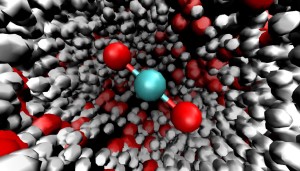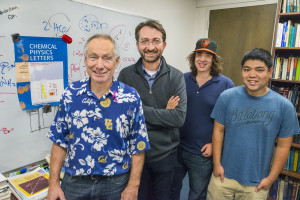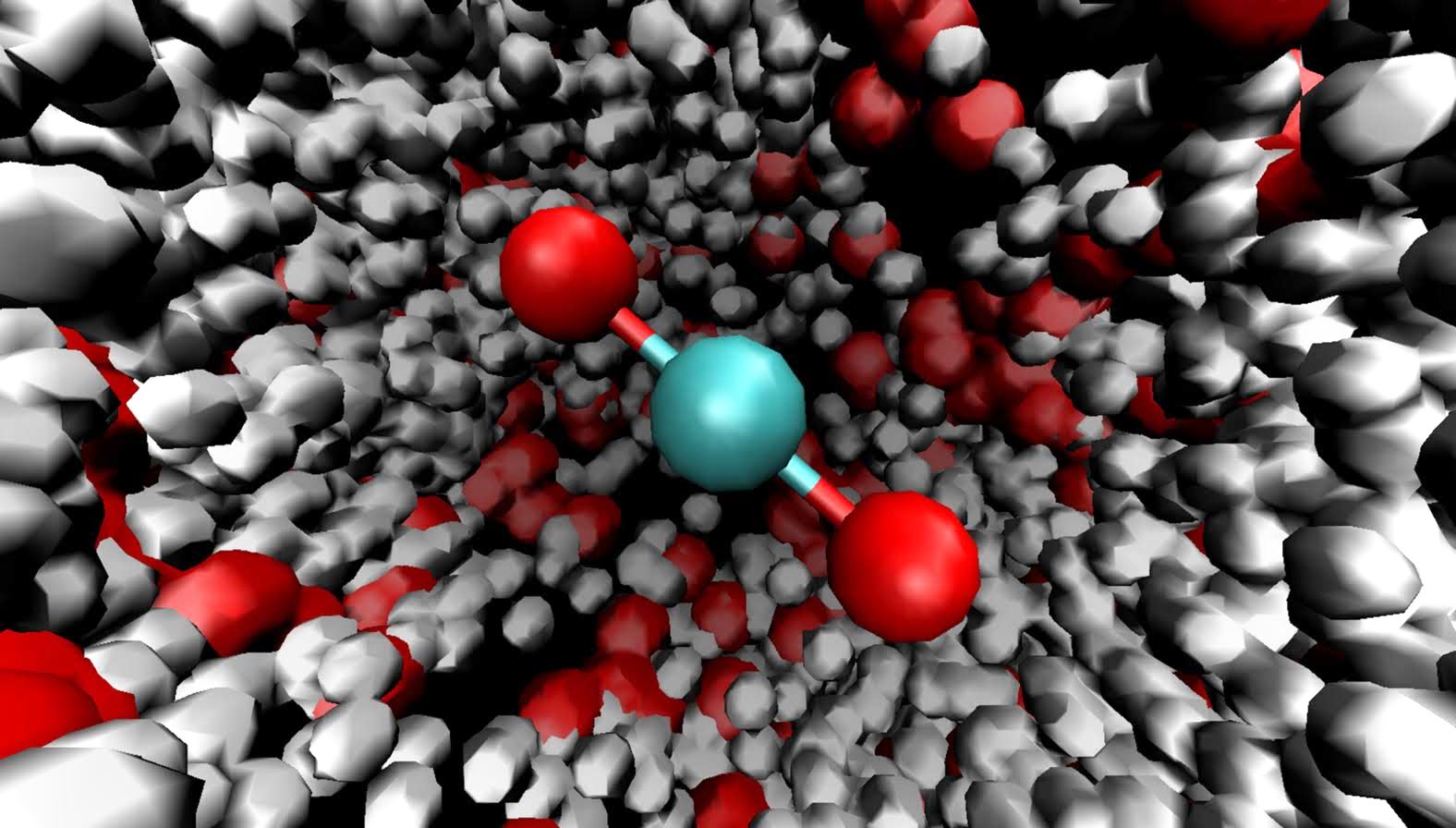
When gaseous carbon dioxide is dissolved in water, its hydrophobic nature carves out a cylindrical cavity, setting the stage for the proton transfer reactions that produce carbonic acid.
Blink your eyes and it’s long gone. Carbonic acid exists for only a tiny fraction of a second when carbon dioxide gas dissolves in water before changing into a mix of protons and bicarbonate anions. Despite its short life, however, carbonic acid imparts a lasting impact on Earth’s atmosphere and geology, as well as on the human body. However, because of its short lifespan, the detailed chemistry of carbonic acid has long been veiled in mystery. Researchers with Berkeley Lab and the University of California (UC) Berkeley are helping to lift this veil through a series of unique experiments. In their latest study, they’ve shown how gaseous carbon dioxide molecules are solvated by water to initiate the proton transfer chemistry that produces carbonic acid and bicarbonate.
“Through a combination of X-ray absorption spectroscopy (XAS), theoretical modeling and computational simulations, we’re able to report the first detailed characterization of the hydration structure of carbon dioxide gas dissolved in water,” says Richard Saykally, a chemist with Berkeley Lab’s Chemical Sciences Division and professor of chemistry at UC Berkeley who leads this research. “Our results will help improve future theoretical modeling of this crucial chemistry by characterizing the initial state of the proton transfer reactions that occur in water.
“This latest work follows a separate recent study in which the hydration structure of carbonic acid itself was characterized. Ultimately, such studies will lead to a complete understanding of how atmospheric carbon dioxide is captured and transformed by ocean surfaces, a crucial role in the carbon cycle. They will also enable us to address how bicarbonate anions interact with calcium and magnesium cations in solution to create the nanoclusters that nucleate limestone formation, and how bicarbonate anions buffer blood and other bodily fluids.”

(From left) Richard Saykally, David Prendergast, Jacob Smith and Royce Lam were part of a team that has provided valuable new insight into the formation of carbonic acid. (Photo by Roy Kaltschmidt)
Saykally and his research group have overcome the challenge of carbonic acid’s short lifetime – about 26 milliseconds – by developing a unique liquid microjet mixing technology. In this technology, two aqueous samples rapidly mix and flow through a finely tipped nozzle that is made from fused silica and features an opening only a few micrometers in diameter. The resulting liquid beam is injected into a vacuum chamber and intersected by an X-ray beam before being collected and frozen out.
Saykally and his group installed their liquid microjet system at Berkeley Lab’s Advanced Light Source (ALS), an electron accelerator/storage ring that serves as a premier source of X-ray beams for scientific research. In earlier experiments, they used their microjet system and XAS technique to characterize the hydration structures of aqueous carbonate and bicarbonate. In this new study, Saykally and his group were able to capture the XAS spectrum of carbon dioxide gas dissolved in water. All of these experiments were performed at ALS Beamline 8.0.1, a high flux undulator beamline that generates X-ray beams optimized for XAS studies.
Saykally and his colleagues determined the hydration structure of carbon dioxide in water by using their XAS spectral data in conjunction with molecular dynamics simulations carried out under the leadership of David Prendergast, a staff scientist in the Theory of Nanostructures Facility at Berkeley Lab’s Molecular Foundry. Calculations were performed utilizing the supercomputer resources of the National Energy Research Scientific Computing Center (NERSC). The ALS, the Molecular Foundry and NERSC are all national user facilities funded by the U.S. Department of Energy (DOE)’s Office of Science.
The results of this study show that the carbonic acid molecule acts as a hydrophobe with an average hydrogen bond number of 0.56. The carbon atom interacts weakly with the oxygen of a single water molecule at a distance of greater than 2.67 Angstroms, and the carbonyl oxygens serve as weak hydrogen bond acceptors. The result is an enhanced tetrahedral water/hydrogen bonding structure, with a local cylindrical cavity carved out in the water solvent.
“Calculated spectral energy shifts and intensities between aqueous carbonic acid, dissolved carbon dioxide and gaseous carbon dioxide correspond well with our experimentally measured spectra,” Saykally says. “In future studies, we will focus on resolving some limitations of our current experimental design and the limitations of molecular dynamics modeling through the implementation of higher level ab initio theories.
The results of this latest study have been published as an Editor’s Choice feature article in Chemical Physical Letters. The paper is titled “The Hydration Structure of Dissolved Carbon Dioxide from X-Ray Absorption Spectroscopy.” Saykally is the corresponding author. Other co-authors, in addition to Prendergast, are Royce Lam, Alice England, Jacob Smith, Anthony Rizzuto and Orion Shih.
Additional Information
For more about the research of Richard Saykally go here
For more about the Advanced Light Source go here
For more about the Molecular Foundry go here
For more about NERSC go here
